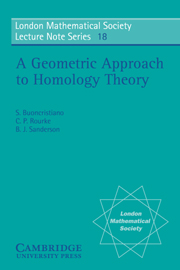III - Coefficients
Published online by Cambridge University Press: 05 April 2013
Summary
In this chapter we give a geometric treatment of coefficients in oriented pl bordism theory. The definition (although not all the theorems) extend to other geometric homology theories and this extension will be covered in Chapter IV, as will the extension to cobordism (mock bundle) theories. Application to general homology theories and connection with other definitions of coefficients will be covered in Chapter VII.
There are two good definitions of coefficients:
1. For a short resolution ρ of an abelian group G we define coefficients in ρ by labelling with generators and introducing one stratum of singularities of codimension 1 corresponding to the relations (see §1).
2. We allow labelling by any group elements, and singularities corresponding to any relation and then, in the bordisms, allow singularities of codimension 2 corresponding to ‘relations between relations’ (see §3).
Definition 1 is very simple geometrically while definition 2 is functorial in G. To prove equivalence of the two definitions involves a further definition, for longer resolutions (in §2). The basic geometrical trick is resolution of singularities and appears in the proof of the universal coefficient sequence in §2. The universal coefficient sequence itself can be seen as the measure of the obstruction to resolution of the final singularity. In §3 it is seen that the universal coefficient sequence is natural for G; consequently by [3] it splits for a large class of abelian groups, including all groups of finite type.
- Type
- Chapter
- Information
- A Geometric Approach to Homology Theory , pp. 41 - 80Publisher: Cambridge University PressPrint publication year: 1976



